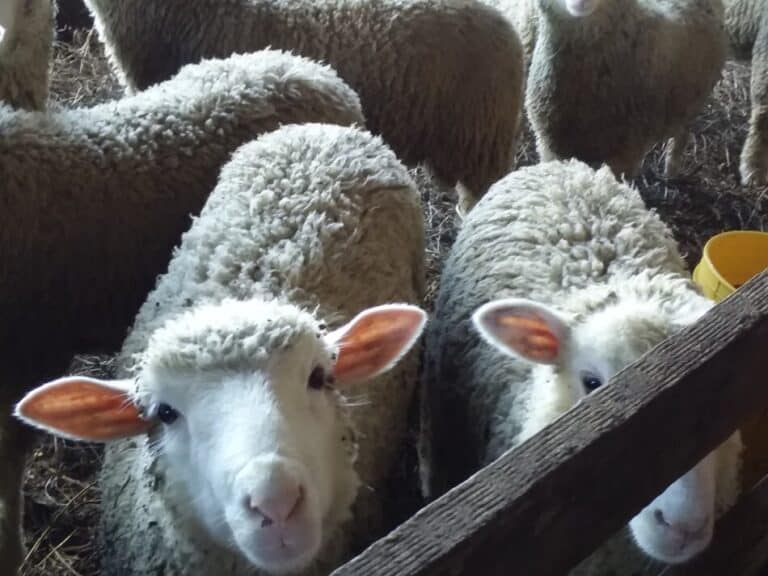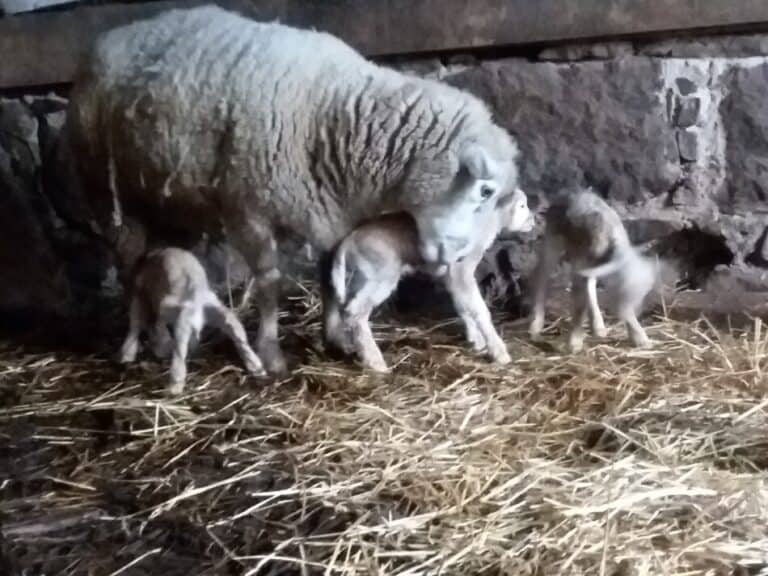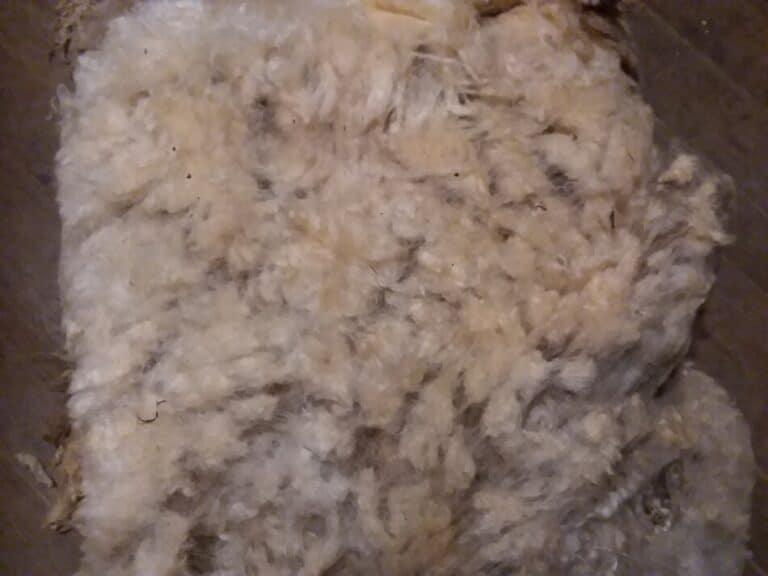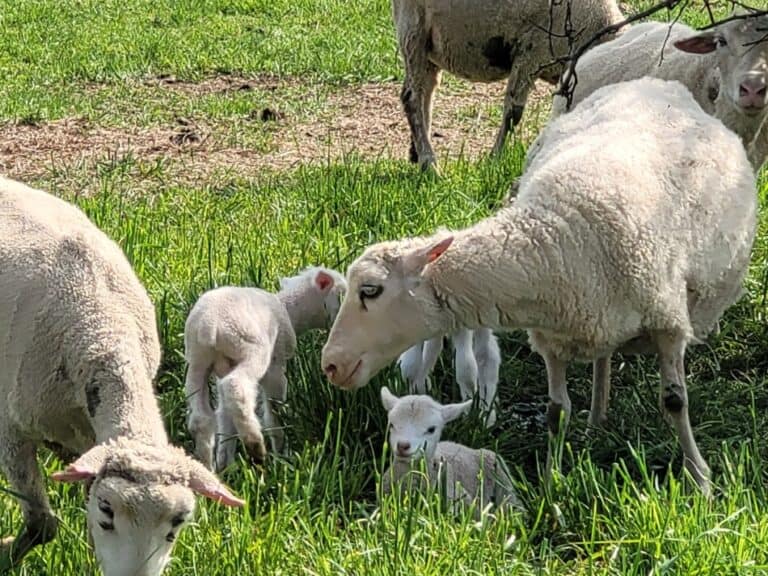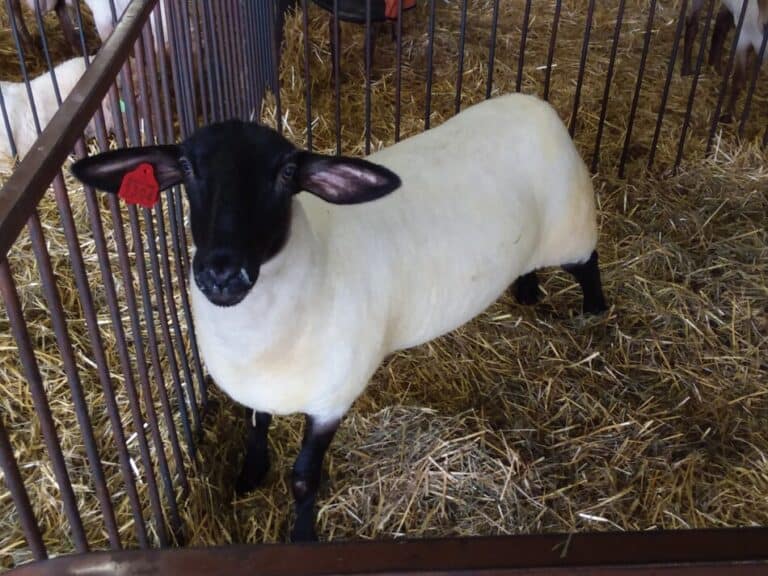How Many Bales Of Hay Do Sheep Need?
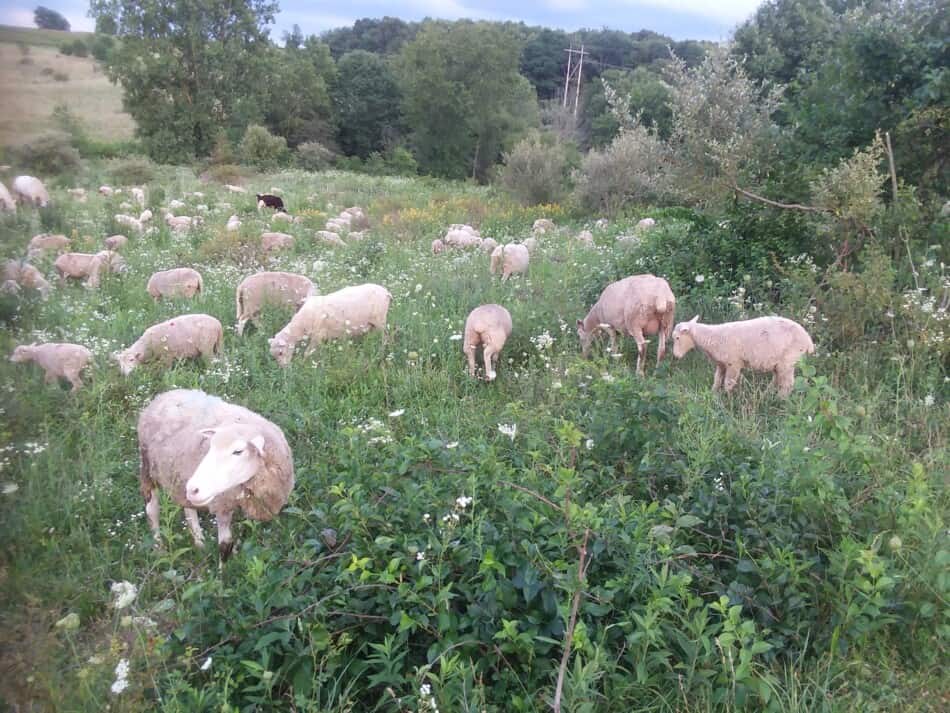
Most flocks of sheep will be fed some hay for the winter. Even as your sheep are munching away on a fall pasture or nipping the late season growth off of your lawn, you know you need to get some winter hay.
How much hay does each sheep need and how many bales will you need to feed per day?
A 130 pound ewe will need 4.55 pounds of hay per day. To feed 10 ewes that weigh 130 pounds each, you would need one 45.5 pound bale per day.
Figuring out how much hay your sheep will need is easy, you just need to know some basics.
We’ll go over calculating the hay needed per sheep and how to figure out the weight of the bales you purchased. All of these numbers are simple to change, in order to fit your situation and your flock’s needs.
Is Raising Lambs For Meat Worth It? gives you a cost breakdown of buying lamb versus raising them yourself.
Sheep For Profit goes over the items you need to have in your budget to successfully raise sheep.
| Sheep | Hay needed |
| 130 pound ewe | 4.55 pounds per day |
| 150 pound ewe | 5.25 pounds per day |
| 10 head 130 pound ewes | 45.5 pounds per day |
| 10 head 150 pound ewes | 52.5 pounds per day |

Calculate the hay need per sheep
The first place to start is to calculate the hay needed by each sheep in your flock. Generally, the number used for daily hay consumption is 3.5% of body weight.
This means that if you have a 130 pound ewe she will need 4.55 pounds of hay per day. 130 x 3.5%=4.55
Of course, you should play around with these numbers to make them suit your operation.
What are the rest of your flock expenses? Read my article Cost To Raise Sheep.
The amounts of hay will be about the same for any ewe lambs you decide to keep in your flock.
Even though, ewe lambs are smaller than ewes (3.5% of their body weight would be less than 4.55 pounds) they seem to eat just about as much. Let the ewe lambs eat what they want, since they are still growing.
Since your ram will be a bit bigger than your ewes, he will eat a bit more than they will. As long as you have plenty of quality hay available to the flock, he’ll get what he needs.
Calculate number of bales needed
If you have 10 ewes in your flock, you’ll need to feed a 45.5 pound bale everyday. If you have 5 sheep, you’ll be feeding about half a bale, you get the idea.
The 45.5 pounds that you need would be about the weight of a nice small square bale or 1.5 light weight small square bales.
Find the weight of the hay, per bale
The seller will know the weight per bale of the hay being sold. You can always weigh one on a bathroom scale, to get a number for what you actually buying.
Getting the weight off of a bathroom scale may work by just putting the bale on the scale, but we’ve never had any luck with that method. We always weigh the person, then weight the person holding the bale.
You should know that the cheaper scales will weigh the same thing differently, depending upon where you place your feet on the platform. Sad, but true! Get a better scale or stand in the same spot on the scale platform.
On a bit of a side tangent, consider getting a really easy to read, easy to use scale. You’ll need it for all manner of things, we use our scales daily.
Figure the bale weight with total load weight
If no weight is given for the individual bales you can calculate it out for yourself using the number of bales in a ton.
An example: Let’s say you bought a load of a nice second cutting grass hay and you are paying by the ton.
The hay seller says the bales are a bit lighter than he would like them to be, but the hay is really high quality.
He tells you that the weight of the load is 1,800 pounds. (There will be a weigh slip showing the weight of the load that most hay sellers will give to you as a receipt.)
As you are helping unload the hay, you are counting bales and come up with 54 bales. You counted because this is the easiest way to get the weight per bale.
By dividing the total weight by the number of bales, you find that these bales weigh 33 pounds each. 1,800 pounds per ton divided by 54 bales=33 pounds per bale
That is lighter than most, but since you are paying by the ton, it does not matter. You only need the weight per bale to give you an idea of how much to feed your flock.
Here’s another example: you buy 1.5 tons of tightly baled, well made first cutting mixed hay. This will be great for your sheep!
You count bales as you are helping unload and come up with 60 bales. Good news, these bales are very typical, having a 50 pound weight per bale.
Take 1.5 tons x 2,000 pound per ton=3,000 pounds of hay
3,000 divided by 60 bales=50 pounds per bale

What is the best hay for sheep?
- Well made, first cutting grass (timothy, orchard grass, etc.)
- Well made, first cutting mixed hay
- Second cutting grass hay
The best hay for maintenance needs sheep is a nice first cutting grass, like timothy or orchard grass that is made early and was never rained on.
Some years, that is a tall order. Other years are very hay friendly, it varies quite a bit.
What Is 1st Or 2nd Cutting Hay? is a good article to start with if you are not sure of hay cuttings and why it matters to you and your sheep.
Well made first cutting hay is great. A nice, well made first cutting timothy is hard to beat!
Rained on first cutting hay is not high quality! Late made hay, with the seed heads sticking out everywhere, is not high quality, either. For either of these situations, bedding is a more appropriate use.
This stuff will be cheap, but there’s very little nutrition here. It’s not worth your money.
A second cutting grass or mixed hay would be fine, but you’ll have to monitor the flock’s condition (fat covering the body).
Alfalfa only hay is probably too rich for your sheep, especially the main flock. A few thin flakes to a pen of nursing moms as a supplement, good call.
However, maintenance needs sheep eating only alfalfa? Not a good idea. That’s too rich of a forage for them and pricey for you. These gals need more of a grass based hay.
If you are having trouble getting the hay you need, think horse hay, or even say it. The words “horse hay” seem to be magic as far as communicating to a hay seller that you want high quality hay.
As the picture notes, we feed haylage to our sheep all winter. They love it and it works well for us. Not all sheep producers agree on this.
There is a higher risk of listeria associated with haylage and silage feeding that you should be aware of, should you consider haylage for your flock.
Here’s a link to another sheep website for more details on sheep and haylage.
A note on regionality: there will be a prevalent hay type in your area, but it may not be one of the plants I have listed. That’s fine. Use whatever is commonly fed to sheep in your area that has an acceptable nutritional value.
Here’s a Penn State article Feeding The Flock, that lists out sheep feed rations, including types of hay and pounds needed, for both 130 and 150 pound ewes.
Sheep can eat only hay
Sheep can eat exclusively hay for the winter. They can also live on hay only if you are in an area where pasture growth is nearly nothing.
Sheep are ruminants, this means they naturally eat grass and other forages as their biologically appropriate diet. Since hay is just dried grass, it works out great as a food source for your sheep.
Lambs need hay or grass to taste test
If your lambs are on a plentiful pasture with their moms, they do not need hay. They will get plenty to eat by nibbling around on the smaller grasses and clover plants in the pasture and nursing from the ewe.
If you are keeping your lambs inside with their moms for now, they will eat some of the hay that they see the ewes eating. They’ll nibble around and gradually build up to eating alongside mom.
Use a creep gate for lamb only hay
You should know that if you put out nice hay for the lambs to snack on, the ewes will hog it all! Unless, of course, you have a creep gate of some sort. A creep gate is a gate that has spaces big enough for a lamb to fit through, but too small for ewes.
When you use a creep gate, you can put nicer, lamb only hay in an area where the ewes can’t reach.
You should know, some sheep are very accepting of a creep gate keeping them out of an area and others will try all day to get through it. Our sheep tend to be the try all day to get through it types!
Avoid low quality or moldy hay
- Late made, overly mature hay
- Moldy hay
- Rained on hay
- Hays that are extremely rich, like 100% alfalfa
As I mentioned above, rained on or late made hay is a mess. Do not use it for your sheep, even if you hear “I’m sure it will be fine for sheep” from the hay seller. No deal.
Low quality or junk hay should never be fed to your flock, there’s no nutritional value. Moldy hay is on this list, as well.
Ironically, alfalfa hay should be avoided for maintenance sheep, as well.
Creep feeding lambs with alfalfa or feeding small amounts while supplementing lactating ewes, fine, but for the general flock, no.
The ironic part is, alfalfa is too rich of a hay source for most sheep feeding situations.
Alfalfa should not be feed because it is “too good”, the opposite of everything else on this list!
I have also mentioned the issue of regional feed sources, in an above section of this article.
You will not have the same hay types available as we do, unless you live in or near Ohio! Use whatever is good, high quality hay in your area.
Sheep hay needs will vary
First off, different stages of the reproductive cycle require different levels of nutrition. We are talking about maintenance sheep here, not lactating or fast growing, young lambs.
Your sheep may need more or less than the 4.55 pounds per day. This is a good place to start, but may not be where you and your flock end up.
Hay nutritional value is variable, from cutting to cutting, year to year and farm to farm. You’ll learn as you go. Just know that you have to monitor your sheep to see if they are getting what they need.
